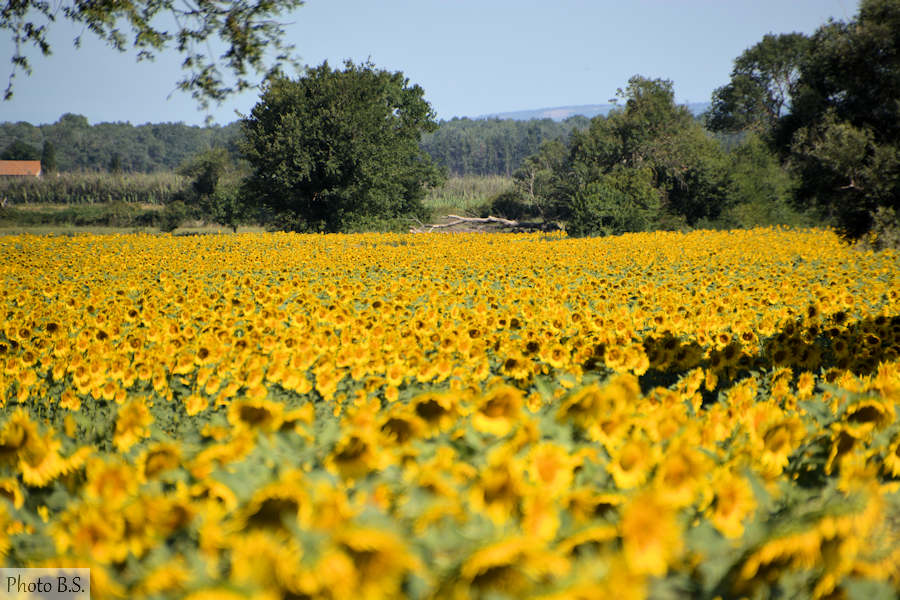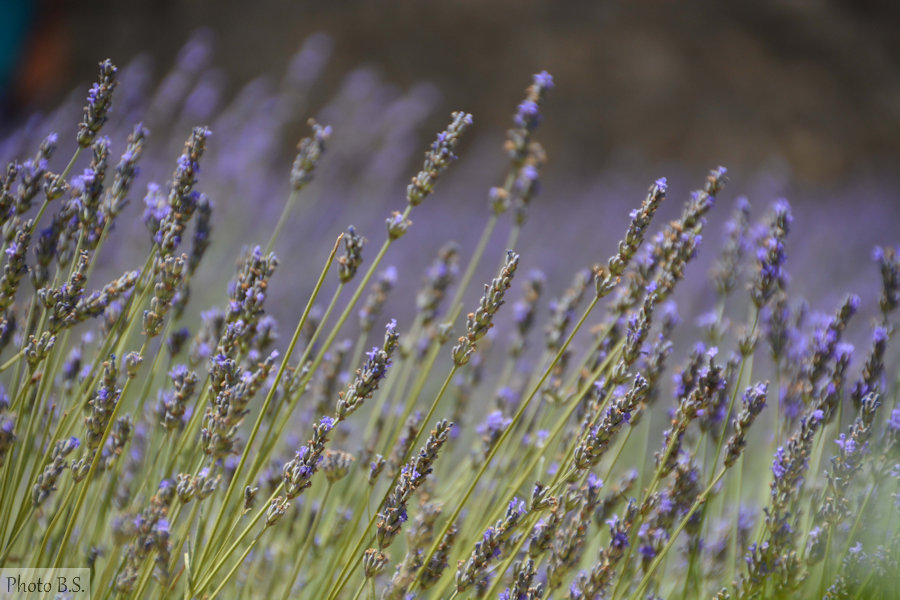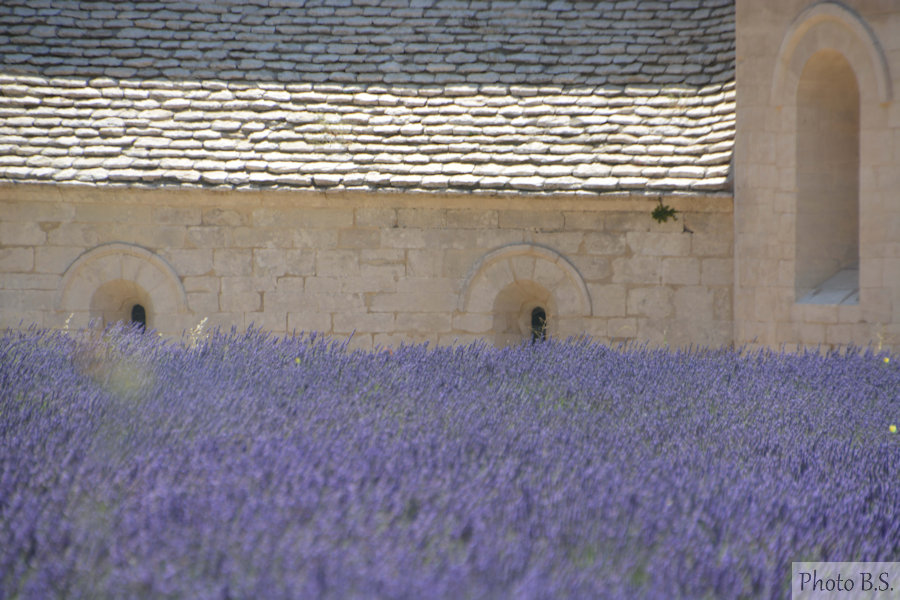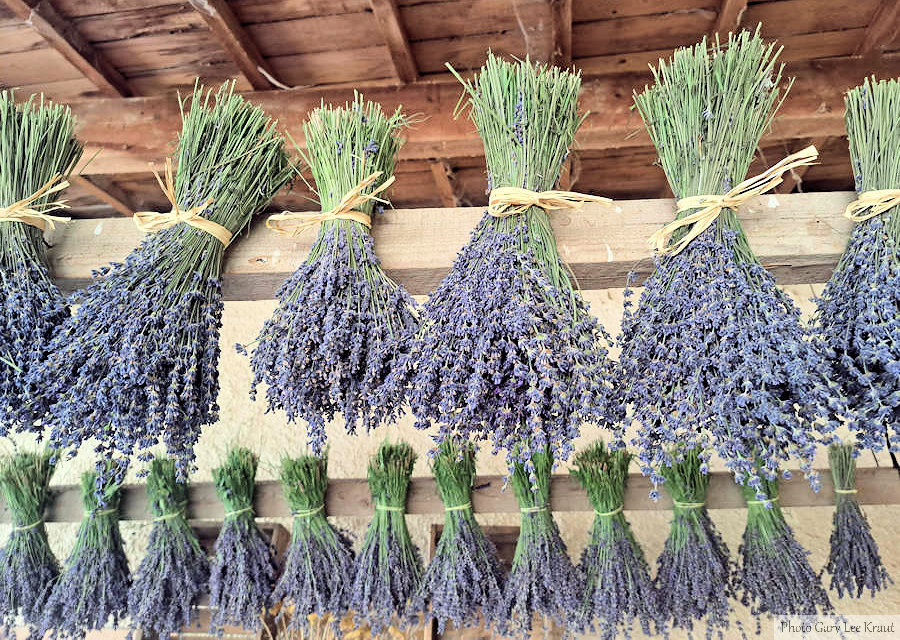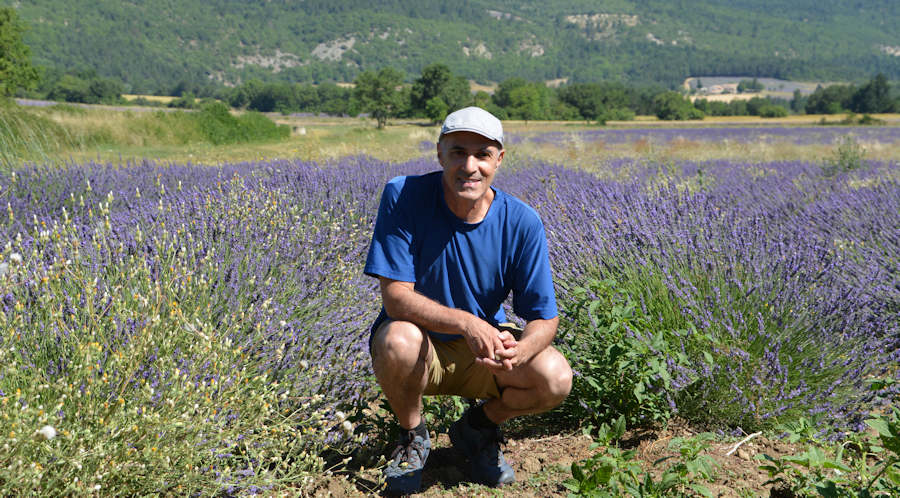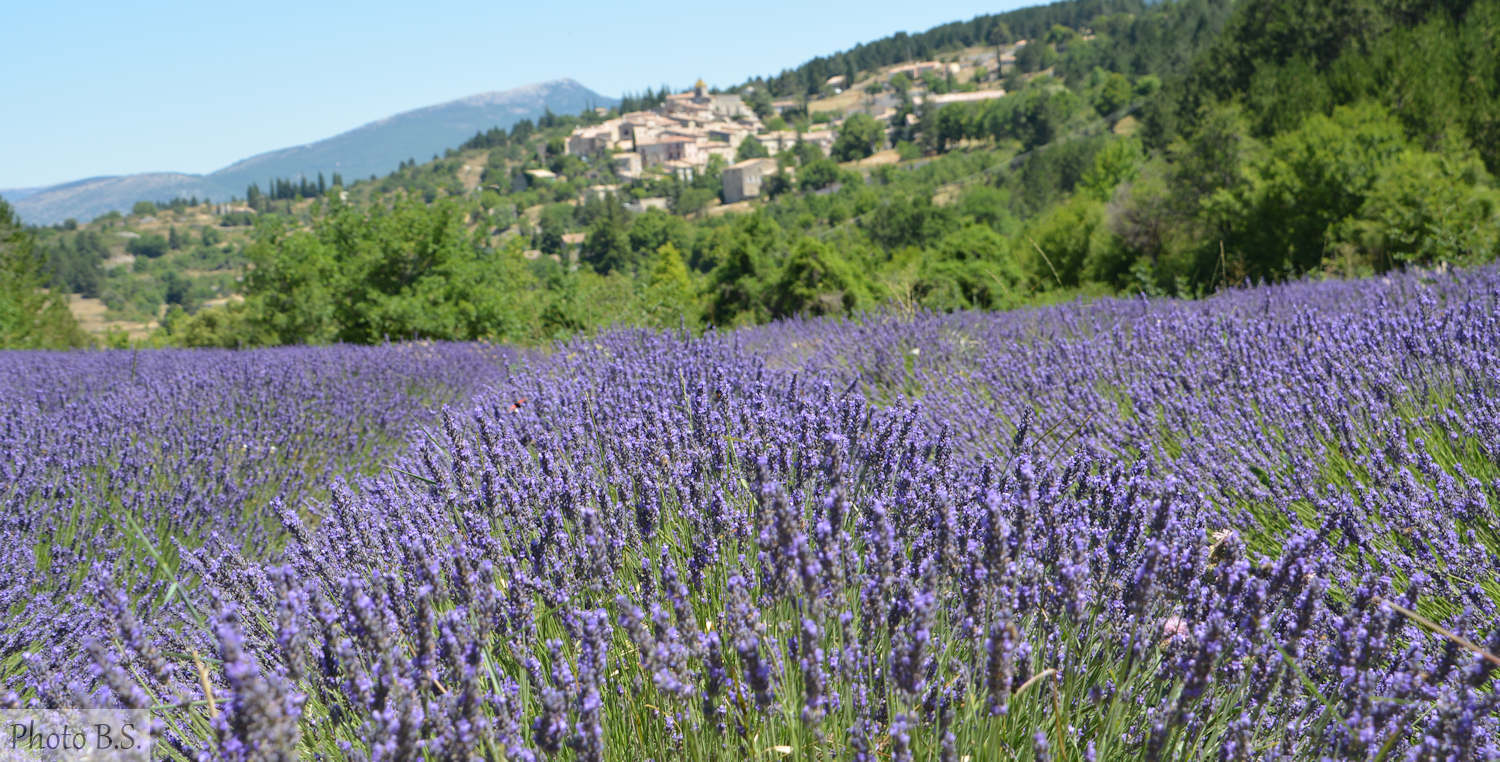
It took a certain amount of luck to find so many lavender fields in full, soothing, uplifting, purple-blue bloom during our early July trip to Provence. Luck, because we couldn’t have known what the weather gods had in store for the summer when we started planning the trip the previous winter. But not all luck. Blooming lavender is to be expected in early July. And I’d made the necessary inquiries several days prior to arrival to find out when and where the flowering would be at its peak.
Call it a combination of luck and due diligence then, and as a result we hit it right at Sénanque Abbey, we hit it right on the plateau surrounding Sault, we hit it right at various points in between, and from time to time we were wowed by bright, eye-catching sunflower fields.
Stunning views of purple-blue fields of lavender in bloom are far from the only pleasure of Provence, but such images have become so engrained in the traveler’s imagination of the perfect Provence vacation that the most common question I get from those planning to visit the region is “When is the lavender in bloom?”
When is lavender in bloom, and where?
Broadly speaking, Provence’s “blue gold” blooms from early June to mid-August, even beyond, though the edges of that 10-week window can be iffy. So let’s say mid-June to late-July to be sure.
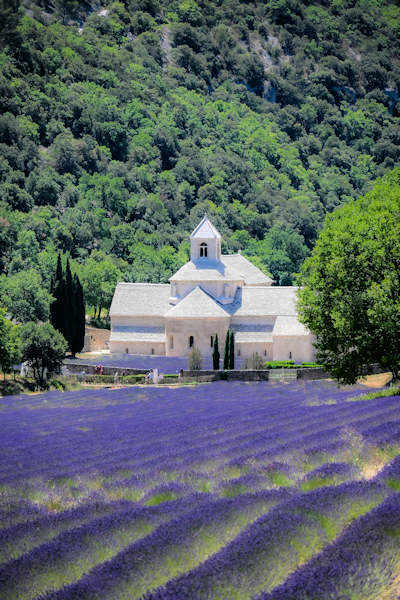
That doesn’t mean you’ll find flowering fields everywhere during that period. Lavender—both “true” lavender and the hybrid lavandin—blooms at different times, in different locations, at different altitudes. It stays in color for a month or more before being harvested, again at different times, locations, altitudes. So don’t come expecting to find all of the fields in full color throughout the summer.
Lavender fields typically begin to flower east of the Rhone River around the second week in June in the lower altitudes in the department of Drôme (particularly in its southern portion known as Drôme Provençale) and in the northern portion of the department of Vaucluse, as well as in Vaucluse’s southern portion in and around the Luberon (e.g. Gordes, Sénanque).
One morning last year, on a 7th of June, while biking along the northern side of the Luberon, after passing several brown-grey fields, I sensed a haze of the palest of purples hanging like fog over long rows of planted mounds—or it was a mirage?
Depending on the type of plant, the weather and the altitude, the flowering begins a week or two or three later on the slopes and especially plateaus further from the Rhone River in Drome, Vaucluse (e.g. Sault) and Alpes du Haute Provence (e.g. Valensole), as well as in bordering departments.
While harvesting of the lower fields may begin as early as July 1, harvesting at the higher altitudes won’t be underway until the second half of the month, possibly not until the end of July or even well into August.
If your sense of the geography of the above-mentioned areas is unclear, see this map of approximate blooming and harvest periods.
Within the periods indicated on that map, those lovely lavender fields won’t be everywhere. You may have to go looking for them. But don’t make a detour to distant fields without first asking someone in the know, such as at a local tourist office. Otherwise, you may arrive only to find long mounds of dirt, as though the fields were a graveyard for the sandworms from Dune. Imagine how disheartening it can be to arrive at a field of dreams only to be told, “Oh, you should have been here yesterday, before the harvest. It was beautiful.”
Travelers needing a lavender fix while visiting the Riviera from mid-July into August may try venturing up to the fields north of Grasse.
Several years ago, on a 6th of August, while accompanying a group that had despaired of not seeing blooming lavender fields at the lower altitudes during their stay, I called around to find out if there had been any lavender sightings that week. Armed with an answer, I then led the group on a long detour from our long-planned itinerary to the vast fields on the eastern side of the Valensole Plateau where, bingo, there it was. Though not the bright magenta or electric purple promised in the glossies or the shocking blue or dark violet seen in photowashed travelgrams, it was a sight to behold: a true pale herbal floral lavender dancing in the breeze atop rounded bushes that snaked in long curving rows pointing toward the Alps.
From year to year and zone to zone, blooming and harvest times will vary. Therefore, when asked to help travelers with planning months in advance of a trip, I advise them to think of colorful lavender fields as a treat rather than a destination so as to avoid breaking any hearts (and getting blamed when lavender dreams turn to dirt).
Learning about Lavender and Lavandin
Along with the pleasure to the eyes, shops throughout Provence sell lavender-scented and lavender-based products for the pleasure of the nose and of the skin—soaps, creams, perfumes, fragrances, sachets, etc.—and of the mouth in the case of lavender honey (the real kind from bees working in the lavender fields). For my taste, lavender honey can be too intensely lavender for most uses, but adding a few dabs to a baguette-and-butter breakfast tartine makes for a sweet and soothing start to the day.
You’ll find lavender products wherever you go in the region. Sénanque Abbey, for example, has a large selection in their shop of monastic products. Nearby, in Cabrières-d’Avignon, between L’Isle sur la Sorgue and Gordes, the Lavender Museum / Musée de la Lavande can teach you about the growing, harvesting and distilling of lavender.
This summer, I chose the Vallon des Lavandes Distillery and neighboring fields in the Sault countryside for our picture-perfect lavender education. The drive itself from the small town of Mazan, where we were staying, offered stunning views of Mont Ventoux before we rounded one final hill and the purple fields around Sault opened before us. Sault (pronounced so, not salt, with a short, crisp o) is on the Vaucluse edge of the Albion Plateau, which covers the corner where Drome, Vaucluse and Alpes du Haute Provence meet. The Albion Plateau is one of the major lavender producing areas of Provence and therefore, when in bloom, among its most photogenic.
So (pronounced Sault), after parking at the distillery, we took an easy and delightful hike along an outlined Lavender Trail. The area isn’t heavily trafficked, but be sure to watch for cars when walking on the road portion of the 5k/3mi trail. (If you drive around the plateau, don’t just stop in your tracks to take in a view but pull over to a secure area.) While you shouldn’t walk into the lavender fields out of respect for the plants and their owner’s private property, I know of no visitor who can resist stepping into the fields for a photo, including this one.
During a tour of its 1947 distillery, the staff at the Vallon de Lavande provides an excellent introduction to the planting and growth of lavender and its common hybrid lavandin and especially to the extraction of essential oils. Lavandin represents three-quarters of the harvest at the 45-hectare (111-acre) domain. It produces six times more oil than true lavender and contains far more camphor, while true lavender, we were told, currently sells for about 180€/kg, about eight times more than lavandin. Some 150kg of plant are required to extract 1kg of oil of true lavender. The deflowered plants serve as combustible for the distillation.
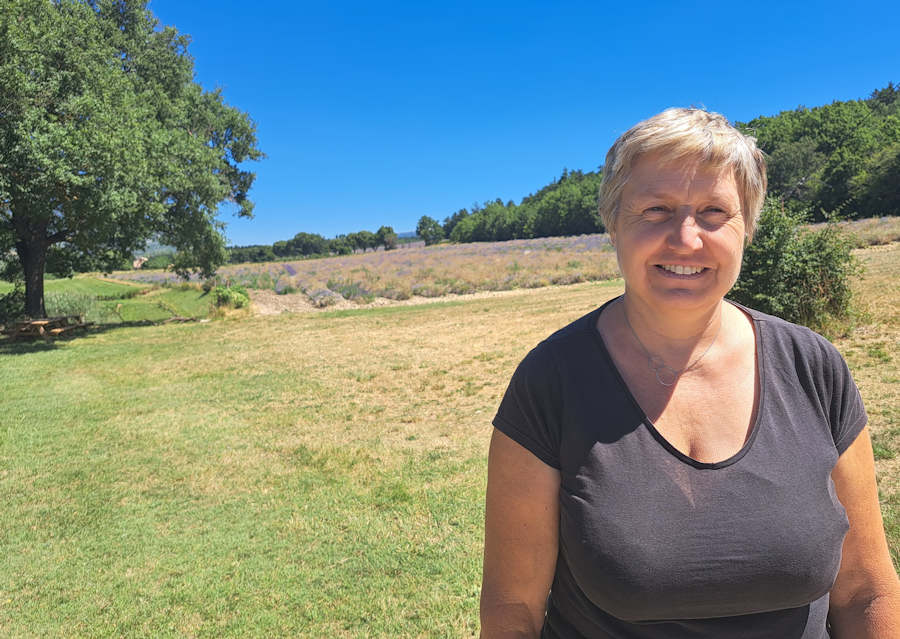
Since it can be quite hot in the afternoon in summer, better to hit the Lavender Trail in the morning, followed by a visit to the distillery. Then drive up the hill to the center of Sault for lunch. We enjoyed a nice meal and a wide view over the plateau from the back terrace of O Pichoun. We followed that up with a pleasant little walk-about in Sault and sniffed into several lavender shops before the pretty ride home.
Sault holds a festival to celebrate lavender in the middle of August, when any remaining flowers are usually cut down. Valensole holds its lavender festival in mid-July.
Sault Cyclists and Mont Ventoux
In Sault in summer, serious bikers abound in their tight shorts and click-clacking cycling shoes. That’s because Sault is a stop on or the starting point for three cycling loops for sporty road bikers:
– an athletic loop that follows the gorge of the Nesque River then back along the hills via Méthamis;
– a lavender-tinged loop along and around the Sault portion of the Albion Plateau,
– and a challenging, 24-km / 15-mi climb to the bald summit of Mont Ventoux, followed by a dangerously high-speed decent back toward Sault.
Regarding the ascension of Mont Ventoux, in-shape road cyclists and those on electric bikes might feel that the first 10 miles from Sault are no more than strenuous, but the true test of fitness comes with the final 10-degree assault. Though the climb from Sault is challenging, the other two ascension routes to the top of Ventoux—from Malaucène and from Bédoin—are even more so, which is why Sault makes for a more popular basecamp. The mountains summit has recently been made more cyclist and pedestrian friendly. Be sure to check the weather report before setting out.
Spelt and Goats
Along with sightings of lavender fields, fruit orchards (cherries, almonds, apricots, etc.) and the occasional sunflower field, you may not recognize fields of small spelt (petit épeautre in French), an ancient grain that’s at home in the hills and plateaus of Provence to the east of Ventoux in the departments of Vaucluse and Haute (Upper) Provence. You’ll find petit épeautre listed on menus as an accompaniment to fish and meat dishes in the region. It’s prepared in much the same way as rice. You may also come across some goats as you bike or drive through the region, which is to be expected given the abundance of goat cheese in the local food markets.
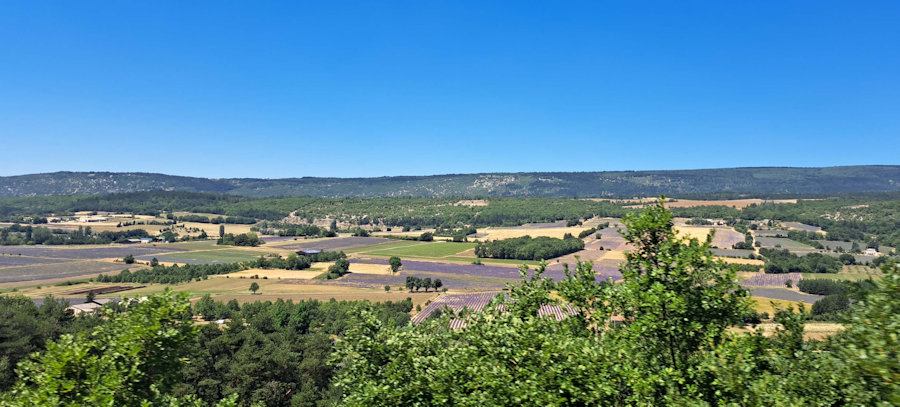
Addresses and further information
Lavender distillery: Sylvie and Thierry Barjot’s Vallon des Lavandes, 965 Route du Vallon (Ancienne route d’Aurel), Le Vallon, one mile north of the village of Sault. Open for free visits July and Aug. Mon-Sat. and upon reservation April-June and Sept.-Oct. See schedule here. There’s a small lavender shop on site.
For other lavender addresses in Vaucluse see here.
Restaurant: O Pichoun, Avenue de la Promenade, Sault. Ask to be seated on the back terrace. Reservations recommended in summer and weekends.
Hotel: In Sault, the 3-star Hôtel Le Nesk, popular with cyclists, can also be a stopover for lavender hunters.
Cycling: In preparing your cycling trip, a good resource is the official cycling site of the department of Vaucluse, which provides information on routes, rental shops, bike-friendly accommodations, luggage transportation services, etc.). But don’t hesitate to be a cyclist without borders so as to connect with the neighboring department of Drôme to the north and Alpes de Haute Provence to the east. In Sault, Albion Cycles, which rents and repairs bikes, can advise on local cycling routes once in the area. Cyclists can also follow portions of the extensive lavender routes described here.
© 2022, Gary Lee Kraut


